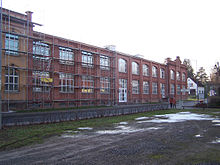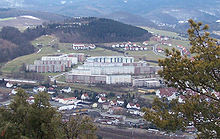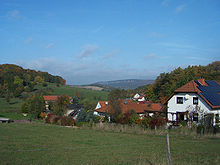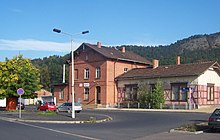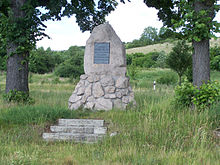Wutha Farnroda
| coat of arms | Germany map | |
|---|---|---|

|
Coordinates: 50 ° 57 ' N , 10 ° 24' E |
|
| Basic data | ||
| State : | Thuringia | |
| County : | Wartburg district | |
| Height : | 250 m above sea level NHN | |
| Area : | 36.61 km 2 | |
| Residents: | 6335 (Dec. 31, 2019) | |
| Population density : | 173 inhabitants per km 2 | |
| Postal code : | 99848 | |
| Area code : | 036921 | |
| License plate : | WAK, SLZ | |
| Community key : | 16 0 63 092 | |
| Community structure: | 4 districts | |
| Address of the municipal administration: |
Eisenacher Str. 49 99848 Wutha-Farnroda |
|
| Website : | ||
| Mayor : | Torsten Gieß (independent) | |
| Location of the municipality of Wutha-Farnroda in the Wartburg district | ||
Wutha-Farnroda is a municipality in the Wartburg district in Thuringia , Germany . It was created on January 1, 1987 through the merger of the previously independent communities of Wutha and Farnroda and has around 6300 inhabitants.
geography
The community lies at the foot of the Hörselberge ( 484 m above sea level ), in the south-west it borders on the Rennsteig . It is located around five kilometers east of the Wartburg in the Thuringian Forest or in its foreland on the old Via Regia trade route .
In the north and east, Wutha-Farnroda borders on the municipality of Hörselberg-Hainich , in the southeast on the municipality of Seebach, in the south on the city of Ruhla , in the southwest on the municipality of Gerstungen and in the northwest on the independent city of Eisenach .
mountains
The landscape around Wutha-Farnroda is shaped in the north by the Hörsel Mountains. The Hangstein ( 483.5 m above sea level ), which is shared with the neighboring town of Ruhla, is the highest point in the municipality . The Herrenberg ( 452 m above sea level ) and the Kleine Hörselberg ( 436.2 m above sea level ) are partly in the Wuthaer and Kahlenberger districts . In the Mosbach area there are: Hangstein ( 483.3 m above sea level ), Großer Drachenstein ( 470.5 m above sea level ), Elsterberg ( 449.8 m above sea level ), Heiligenberg ( 425.4 m above sea level) ) and the Triftberg ( 402.9 m above sea level ). In the Farnroda district are: Großer Ebertsberg ( 397.6 m above sea level ), Rehberg ( 368.4 m above sea level ) and the Wittgenstein ( 326.5 m above sea level ). The Kambühl ( 453.6 m above sea level ) and the Fuchsberg on the Seebach border ( 427.5 m above sea level ) are located in the Schönau and Deubach districts .
Waters
The Hörsel , with its tributaries Erbstrom , Mosbach, Deubach and Burbach, forms the natural water system. The lower section of the hereditary current was also called Wuthaha in the early Middle Ages - hence the place name Wutha. Numerous small ponds are located in all parts of the village and are used for fish farming.
Local division
Wutha-Farnroda has consisted of the districts since the regional reform of 1994
- Wutha-Farnroda with
- Schönau ad Hörsel with
- Mosbach (about 1,350 inhabitants)
-
Kahlenberg with
- Kahlenberg (360 inhabitants)
- Burbach (24 inhabitants)
history
The Lords of Farnroda were mentioned for the first time in 1260, the church and place Farnroda were first mentioned in 1272 and 1278, and at this time also a Kahlenberg castle . In addition to Farnroda, the rulership of Farnroda also included Eichrodt, Wutha, Seebach and Burbach and had been in the possession of the Burgraves of Kirchberg from the 15th century , who used Farnroda for a long time as their headquarters until it was settled as a landgrave-Thuringian fiefdom in 1799 Carl August von Sachsen-Weimar-Eisenach fell back. In Farnroda you can still visit the tower of a now defunct moated castle from the 12th century. The Laurentius Church there with a separate bell tower was first mentioned in the 13th century.
Wutha emerged from two rural settlements, from Eichrodt to the west (mentioned as Eichriet in 1349 ) and the hamlet of Wutha to the east - originally Wuathaha ( the angry rolling brook , first mentioned in 1349). At least since the beginning of the 19th century, Eichrodt, Wutha, the Rehhof and Burbach formed a community called Eichrodt. Between Eichrodt and Fischbach (the latter since 1922 to Eisenach) freed on 17 October 1806 Lieutenant Hellwig with 55 Hussars 4000 after the Battle of Jena-Auerstedt captured Prussia from the hands of Napoleon's army. Since 1907 a plaque on a stone "Hellwig monument" between Weinbergstrasse and the driveway to the motorway slip road has been commemorating this.
With the construction of the railway between Gotha and Eisenach, opened in 1847, Wutha was initially given a stop so that luggage and goods could be transported more quickly to the neighboring town of Ruhla - a place characterized by industry as early as the 19th century. With the construction of the Wutha – Ruhla railway line that followed, in 1879/80 the station was upgraded to the station and a goods shed and a loading street were built. The Röber brothers special machine construction , a family business founded in Wutha in 1852, which specialized in the manufacture of agricultural machines and seed cleaning systems at an early stage, benefited from the construction of the railway . The export-oriented company existed until 1948 at its headquarters in Wutha-Farnroda. Legal successor in the GDR was the company Petkus Landmaschinenwerk Wutha .
In 1922 Eichrodt was incorporated into Eisenach (Burbach came to Kahlenberg) and in 1924 - like numerous other surrounding communities - again from Eisenach. Since then the community has been called Wutha.
The oldest part of the community is Mosbach (first mentioned in 1197). Kittelsthal (now part of the city of Ruhla ) belonged to Mosbach until the 18th century. Both villages still form a common parish today.
Kahlenberg was mentioned in 1250, Schönau and Deubach were first mentioned in 1350. Until the state of Thuringia was founded on May 1, 1920, these places belonged to the Duchy of Saxony-Gotha for a long time , until 1828 to the Duchy of Saxony-Gotha-Altenburg and until 1918 to the Duchy of Saxony-Coburg and Gotha , then until 1920 to the Free State of Saxony-Gotha .
Religions and denominations
In Wutha-Farnroda there are historically three Evangelical Lutheran parishes: Wutha-Farnroda, Mosbach-Kittelsthal and Schönau-Kälberfeld with Deubach and Kahlenberg. However, the majority of the population is non-denominational. Roman Catholic believers and supporters of the New Apostolic Church belong to the parishes in Eisenach or Ruhla.
Incorporations
On January 1, 1987, the previously independent municipalities of Wutha and Farnroda merged because of the construction of the prefabricated housing estate Auf dem Mölmen , which began in 1984 and is located in both the Wutha and Farnroda districts. In the spring of 1994, the previously independent communities Mosbach, Schönau an der Hörsel and Kahlenberg were incorporated.
On December 18, 1997, Wutha-Farnroda successfully fought against a statutory incorporation into the city of Eisenach before the Thuringian Constitutional Court .
Population development
The municipality of Wutha-Farnroda is, based on the number of inhabitants, the third largest municipality in the Wartburg district. In 1990 there were around 8,900 inhabitants in what is now the municipality.
The prefabricated housing estate Auf dem Mölmen , which has been under construction since 1984 , was a focus of the GDR's housing program. In addition to almost 1,700 apartments, two day-care centers (kindergartens with crèches ), two ten-class general polytechnic high schools , a residential area department store (HO), a residential area restaurant, a full-time youth club with a discotheque, doctor's offices and a shopping mall were built between 1984 and 1990 . In 1990 the planned expansion of the residential area was almost half finished. The further construction was stopped in 1990.
By 1994 the population in this prefabricated housing estate had grown to over 4,000. After that it stagnates. Between 1998 and 2002 in particular, the residential area lost more than 1,000 inhabitants, particularly due to the discontinuation of job creation programs. The vacancy rate of the apartment blocks in the residential area was over 40% in 2002. Since 2003, the existing building fabric has been radically dismantled as part of the urban redevelopment funding program . At the same time, the municipality was able to upgrade the residential area with the support of this funding program of the Federal Republic of Germany. Generously designed green spaces were created. The kindergarten with crèche and the access roads have been renovated. Two new food markets and an old people's home were built.
The neighboring residential developments Rehbergsiedlung , Hörselbergblick and the residential complexes Auf der Hutweide in Kahlenberg, Eisenacher Straße in Eichrodt, Stüblingshof and Am Schloßpark in Farnroda were built in the early to mid-1990s . Numerous new residential buildings were also built in Mosbach and Deubach.
|
|
|
|
|
(As of December 31st)
politics
Municipal council
The municipal council of Wutha-Farnroda consists of 20 council members. The municipal council election on May 26, 2019 resulted in the following distribution of seats:
| Party / list | Seats | +/- |
| Wutha-Farnroda Alliance | 6th | - 1 |
| CDU | 5 | ± 0 |
| The left | 3 | - 1 |
| SPD / Awakening Wutha-Farnroda | 2 | - 3 |
| AfD | 4th | + 4 |
| Green | 1 | + 1 |
mayor
Mayor of the community is Torsten Gieß (non-party, formerly SPD ). He took office on January 15, 2003 as the successor to Ernst Kranz, who was elected to the Bundestag, and was last re-elected on November 16, 2014 for a further six years.
Previous mayors of Wutha-Farnroda:
| Surname | Political party | from | to |
|---|---|---|---|
| Helmut Heilwagen | SED | January 1987 | October 1989 |
| Frank Engel | SDP | November 1989 | May 1990 |
| Ernst Kranz | SPD | May 1990 | September 2002 |
| Ingo Jary (acting) |
CDU | October 2002 | January 2003 |
| Torsten Giess | Independent until November 18, 2013 SPD |
since January 15, 2003 |
coat of arms
Blazon: "The coat of arms shows a shield split from silver and red, covered with a split heart shield, which is split from silver and black five times at the front and shows an upright black lion on silver at the back."
Partnerships
- Municipality Weimar (Lahn) , District Marburg-Biedenkopf in Hessen , 1991
- Kamienica Municipality , Powiat Limanowa , Lesser Poland Voivodeship , since 2007
Culture and sights
Museums and galleries
Hörselberg Museum
The Hörselberg Museum is located in a listed building next to the Schönau Church, the old school and the rectory. The local history museum shows the geology , fauna and flora of the Hörselberg region with changing focuses , explains the famous caves of the Hörselberg mountains and karst phenomena in the nature reserve , it is also dedicated to researching the legends and myths of the Hörselberg mountains. The permanent exhibition includes a mineral collection and an extensive collection on the baking trade. A special feature is the communal oven, which is used several times during the year and is operated by the Schönau bakers.
Rathausgalerie
On the initiative of the Bulgarian painter Todor Naidenow , who lives in Wutha-Farnroda and who comes from Bulgaria, a gallery was established in the stairwells of the municipal administration in Wutha-Farnroda , which every six months gives artists the opportunity to exhibit their pictures, art photographs and sculptures.
Old Town Hall Farnroda
The anteroom of the old town hall of Farnroda, which is now used as a community library, tourist office and association building, has been exhibited a diorama of the Farnroda castle complex around 1900 since 2006 . It was built by Winfried Nolte with the assistance of Karl Rennert, who came up with the idea.
music
The musical life is supported by the Volkschor Mosbach e. V., the men's choir Schönau e. V. and the church choirs in Farnroda, Mosbach and Schönau.
Attractions
The district of Farnroda is characterized by a historical center. The castle park is located next to the Farnroda castle tower from the 13th century. The neighboring Laurentiuskirche was built with a separate medieval bell tower. The Farnroda primary school from 1909 is still standing today. The ruinous Farnroda Castle was demolished in 1997. A model in the Farnroda home parlor and some decorated stones on the edge of the park reminds of its existence. The church and the rectory in the Schönau district, together with the cemetery and other outbuildings, form an ensemble of monuments, today the location of the Hörselberg Museum. The nearby Hörselmühle is a technical monument. There are several restored four-sided courtyards in Kahlenberg, and one in the Burbach district has the remains of a moat. The late Romanesque church of Deubach is also worth seeing.
The Eichrodt district also has a historic town center with a gymnasium and the old school. In the north corridor there are two historical monuments and the war memorial in the alder trenches. The historic building of the former Röber / Petkus agricultural machinery factory is in Wutha. In the street village of Mosbach there is a church with a historic organ.
Parks
The Röbersche Park at the town hall is one of the most beautiful parks in the region. Like the two municipal administration buildings, it belonged to the Röber family until 1952, owners of the special factory for cleaning and sorting machines opposite (today: Petkus Technologie GmbH).
In Farnroda there is the castle park with a pond, playground, a traffic garden and a fairground for open-air events.
Natural monuments
There are many natural monuments in the municipality. These include the small Hörselberg, the Mosbacher Linde, the Linden am Hellwigdenkmal, the Kirchtal (FND), the Hangstein, the Mosbacher Ochsenstall, the Drachenstein, the Wuthaer Reformation (FND), the Wittgenstein and the Große Ebertsberg (NSG).
Memorials
A memorial in the Erlengräben in the municipality of Wutha-Farnroda was erected in 1946 and commemorates 455 named Soviet prisoners of war and forced laborers who fell victim to forced labor in Eisenach and the surrounding area during World War II , died in air raids or epidemics.
freetime and sports
- The community has numerous sports and leisure facilities.
- The football and sports fields are in Farnroda (at the Hörselberghalle) and in Mosbach (Langetalswiese).
- In Mosbach there is a swimming pool (Waldbad Mosbach).
- There are football fields in Deubach, Mosbach, Farnroda and Auf dem Mölmen.
- The Hörselberghalle in Farnroda and the Triftberghalle in Mosbach are available as sports halls for indoor sports. These halls are also used for festive and cultural events. A bowling alley is integrated in the Hörselberghalle.
- The equestrian center in Kahlenberg in Zapfengrund offers the opportunity for amateur equestrian sports. The riding stables in the field and Trenkelhof on the outskirts of Eisenach use the extensive forest and meadow areas around Mosbach and Wutha for practice and adventure tours.
- The boxing club Wutha-Farnroda is led by two-time Kazakh champion and winner of the Soviet military championship in 1984, Viktor Bitjakow.
- The climbing rocks in the Mosbacher Hansbachtal are particularly popular, here you can learn to climb on rock sections of varying difficulty.
- For dog sports fans there is a training facility in Farnroda, on Wittgenstein. The Mosbach sled dog race is also well known throughout Thuringia, it also takes place when there is not enough snow and had about 60 participating mushers with 150 sled dogs on the Easter weekend of 2016.
- A halfpipe was built at the Crocodil youth club in the Mölmen residential area .
- The former ski hut on Rehberg is reminiscent of the winter sports club, which today is mostly active in neighboring Ruhla due to the lack of snow. Previously existing ski jumps are no longer available.
Regular events
- The first highlights of the year are the ceremonial meetings and the children's carnival of the Farnroda Carnival Association FKV 1965 e. V.
- Traditionally, May Day is celebrated in Farnroda in the castle park and at the Schönau fire brigade.
- The museum festival is held in Schönau in mid-May.
- On or about Midsummer in the Schönauer drift and bonfire takes place.
- The fire brigade's castle park festival usually takes place in early June in Farnroda.
- In autumn, the fair first takes place in Schönau (1st September weekend), then in Mosbach (1st October weekend).
- In mid-September is the baking women festival in Schönau. The Association of Schönauer Backfrauen was founded in 1997 when the stone oven at the local history museum was being restored. The aim of the association is to maintain the traditional way of life in the village, to take care of cultural events in the region, as well as appearances at family celebrations. Traditional and seasonal baked goods are on offer - mostly based on old recipes.
- The community's independence day on December 18 is also celebrated.
- The day of the open monument and the mill day on Whit Monday recorded an increase in visitors every year.
- The home and hiking association Hörselberggemeinde e. V. organizes its participation in the Eisenach summer prize parade , the Herb Sunday on the Hörselberg, the harvest festival and autumn festival on the Großer Hörselberg and the fairytale forest hike on the Kleiner Hörselberg with pre-Christmas presents for the youngest.
Economy and Infrastructure
traffic
Road traffic
Wutha-Farnroda is on the B 88 ( Eisenach - Ilmenau ). There is a connection to the Bundesautobahn 4 in a westerly direction via the former section of the A4 at the Eisenach-West junction, which has been downgraded to a motor vehicle ( B19 / B84 / B88) and in an easterly direction via the former Bundesstraße 7 , which was downgraded to a state road at the beginning of 2010, at the Sättelstädt junction .
Rail transport
In the districts of Wutha and Schönau there is one stop each on the Halle – Bebra railway line ( Frankfurt am Main - Halle / Leipzig ). Up until 1967 there was a stop in Farnroda on the now closed line of the Wutha – Ruhla railway (Rühler Bimmel) .
Transportation
Wutha-Farnroda is connected to the neighboring communities by the bus lines of the transport company Wartburgkreis and a line of Regionalverkehr Gotha (RVG) .
In addition to its importance for the transportation of schoolchildren, bus transport is also important as a feeder to the train station and for the surrounding communities that are geared towards hiking tourism.
Bike paths
The nationally important route Thuringian city chain leads through Wutha-Farnroda along the Hörsel. In April 2010 the Tannhäuser cycle path from Wutha-Farnroda to Barchfeld via Ruhla and Bad Liebenstein was inaugurated.
Public facilities
Health and care facilities
The medical care center MVZ Bad Salzungen, Wutha-Farnroda plant and several medical practices provide basic medical care for the residents.
The kindergarten and day care center on Fliederweg are located in Wutha / Mölmen, the facility was completely redesigned in 2004/2005; the Bertold-Anzius-Kindergarten in the district of Farnroda was inaugurated as a new building in December 2006; the kindergarten of the Mosbacher Waldspatzen is located in the center of Mosbach; the kindergarten of the Schönau, Deubacher and Kahlenberger Hörseltalzwerge is located in the center of Schönau. The youth club “Crocodile”, which was extensively renovated in 2015 and managed by the AWO, is used for the leisure activities of schoolchildren and young people. The “People's Solidarity Care Center on Rehberg” is located in the Mölmen residential area. The Diakonie-Verbund Eisenach GmbH operates the “Elisabethenhöhe” dormitory in the Kahlenberg district.
fire Department
The volunteer fire brigade has bases in the districts of Wutha, Farnroda, Mosbach and Schönau.
education
The Hörselbergschule elementary school and the Wutha-Farnroda state school are located in the Mölmen residential area . A branch of the Adult Education Center Wartburgkreis is available with educational offers for adult education. There is a community library in the Farnroda district.
Commercial areas
- The An der B7 industrial park is located on the eastern outskirts of Wutha. It has a total area of 36 ha.
- The industrial park An der Allee, which is about the same size and is already fully occupied, is located on the western outskirts of Farnroda. It is a center of the electronics industry in the Wartburg district.
- The Röber business park was created in 2009 on the former Petkus site with the help of the Thuringian State Development Corporation. It is located in the Wutha district. In the meantime, 12 companies with 170 employees have settled on the site.
Established businesses
- The largest company is Thüringische Weidmüller GmbH, founded in 1990, with more than 270 employees. The company, which is part of the Detmold- based Weidmüller Group, is one of the most important manufacturers of components for electrical engineering.
- Petkus Technologie GmbH - formerly the world's largest producer of machines for processing and cleaning seeds - is based in the Wutha district with around 100 employees. The company emerged in 1949 from the company Spezialmaschinenbau Gebrüder Röber (Wutha) founded in Wutha in 1852 .
- The Herbacin Cosmetic GmbH is since 1905 resident in Wutha manufacturer of natural cosmetic products with a worldwide distribution.
Personalities
Sons and daughters of the church
- Karl Friedrich von Heusinger (* 1792 in Farnroda, † 1883 in Marburg), physician, professor, founder of comparative pathology
- Carl Friedrich August Mosengeil (* 1773 in Schönau, † 1839 in Meiningen), stenographer, one of the inventors of the German shorthand
- Richard Stegmann (* 1889 in Schönau, † 1982 in Würzburg), cornet and trumpet virtuoso
- Franz Kleinsteuber (* 1886 in Farnroda, † 1961 in Würzburg), architect and representative of " New Building "
Personalities who have worked on site
- Friedrich von Hellwig (1775–1845), freed 4000 Prussians from the hands of the Napoleonic army at Eichrodt on October 17, 1806 after the battle of Jena and Auerstedt
- Adolf Bube (1802–1873), poet of the song about the little Jesus fountain in the community
- Georg Segler (1906–1978) was a German agricultural scientist, engineer, author and inventor
literature
- Illustrated books Wutha-Farnroda Volumes I – IV . Geiger, Horb am Neckar 1991, 1992, 1997 and 2003, ISBN 3-89264-596-5 , ISBN 3-89264-706-2 , ISBN 3-89570-284-6 and ISBN 3-89570-859-3 .
- Jürgen Siebert (Hrsg.): Festschrift 800 years Mosbach (Thür.). 1197-1997 . Verlag + Druckerei Löhr, Ruhla 1997.
- Lutz Baumbach, Birgit Eichler, Christina Reißig: Commemorative publication for the 750th anniversary of Kahlenberg. (1248–1998, local history) . Festival Committee 750 Years of Kahlenberg, Wutha-Farnroda 1998.
- Festkomitee (ed.): Festschrift 650 years of Wutha . Printing and publishing house Frisch, Eisenach 1999.
Web links
Individual evidence
- ^ Population of the municipalities from the Thuringian State Office for Statistics ( help on this ).
- ↑ a b Resolution of the Council of State of the GDR of October 20, 1986. Journal of Laws Part I, page 446
- ↑ Thuringian Land Surveying Office TK25 - sheet 5028 Eisenach O , Erfurt 1998, ISBN 3-86140-048-0
- ^ Thuringian ordinance on the dissolution of the communities Kahlenberg, Mosbach and Schönau and their integration into the community of Wutha-Farnroda of March 1, 1994 (GVBl p. 407)
- ↑ Municipal council elections 2019 Wutha-Farnroda , accessed on June 4, 2019
- ↑ Thüringer Allgemeine : Torsten Gieß remains in office , accessed on November 20, 2014
- ↑ mdr.de ( Memento from December 2, 2013 in the Internet Archive ), accessed on November 22, 2013
- ↑ Thüringer Landeszeitung : Vierbeiner im Gallop in Mosbach , accessed on March 28, 2016
- ↑ Christa Reissig: 5 years of Schönauer baking women . In: Hörselbergbote. Issue 50. Wutha-Farnroda 2002, pp. 46-47
- ↑ District Office Wartburgkreis (Ed.) Changes after approval of the motorway . In: Kreisjournal 6-2010 of March 24, 2010.
- ↑ Verkehrsgesellschaft Wartburgmobil - regional transport offers and current timetables from June 1, 2019
- ↑ A sporty ride on the Tannhäuser Cycle Path. In: Thuringian city chain. Online portal. Archived from the original on June 5, 2012 ; Retrieved March 28, 2010 .
- ↑ http://www.vhs-wartburgkreis.de/
- ↑ a b industrial areas - on the homepage of the municipality of Wutha-Farnroda
- ↑ Herbacin website , accessed June 4, 2019






